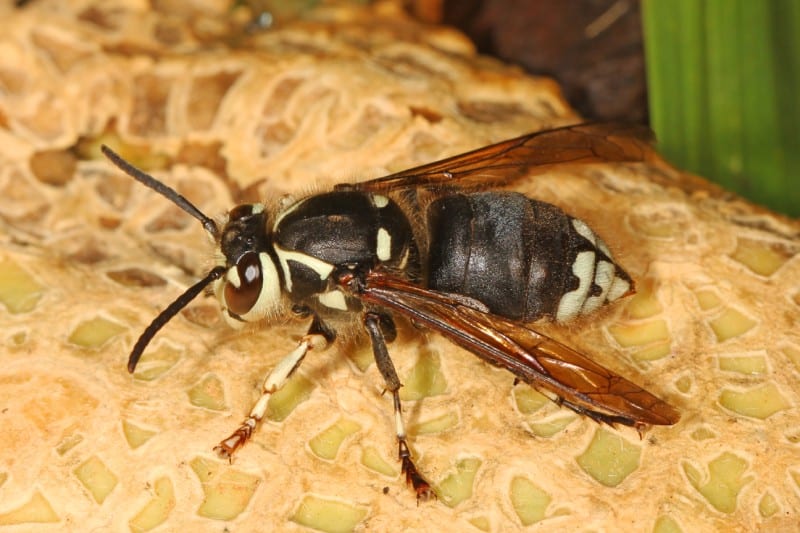
Bald-Faced Hornet Facts
- Despite its common name, the fierce-looking Bald-Faced Hornet does not actually rank as a true hornet. This surprising fact only proves once again that names can be deceiving.
- This amazing eusocial insect actually constitutes a specific species of the yellow jacket. Furthermore, it remains well known for its construction of large conical nests, built from paper-like materials.
- The colonies of this rather impressive invertebrate also sometimes contain as many as 700 workers. This counts as the largest number of workers of any species within its genus.
- The insect builds its nests typically in trees, or under the roofs of buildings. Further, the insect will aggressively defend the nest, repeatedly stinging possible predators.
- Finally, its distinctive name understandably derives from the fascinating markings on its face. These, along with its overall coloring, distinguishes it from others in its genus.
Related Articles
Jewel Wasp Asian Giant Hornet Sweat Bee
Bald-Faced Hornet Physical Description
First of all, the first description of the visually remarkable Bald-Faced Hornet occurred in 1763. First, the majority of related species appear black and yellow. Yet, this variety typically appears black and white in color. The majority of its white coloring also appears on the face.
Further, this species also typically attains a larger size than other yellowjacket varieties. However, it nonetheless remains somewhat small. Due to this trait, the adult attains an average length of about 0.75 in (19 mm).
Furthermore, workers remain covered in numerous small hairs. Meanwhile, however, the body of the queen remains hairless. In addition, the queen typically attains a much larger size than the rest of the colony.
- Kingdom: Animalia
- Phylum: Arthropoda
- Class: Insecta
- Order: Hymenoptera
- Family: Vespidae
- Genus: Dolichovespula
- Species: D. maculata
Photographer: Katja Schulz
CC License: https://bit.ly/1ryPA8o
Bald-Faced Hornet Distribution, Habitat, and Ecology
The aggressive yet lovely Bald-Faced Hornet inhabits areas throughout North America, including southern Canada. Yet it seems most prevalent in the southeastern sections of the United States.
Despite its aggressive nature, this species prefers to build its nests in forested regions. Yet it will when necessary, establish colonies near urban areas, even sometimes on the sides of inhabited structures.
This fascinating creature also has an omnivorous diet. While humans often fear it, the Bald-Faced Hornet actually serves a beneficial purpose. It consumes large numbers of flies, caterpillars, and spiders.
The insect also possesses a unique defense mechanism, in addition to its painful sting. It also has the ability to squirt venom from its stinger into the eyes of small predators invading the nest.
Species Sharing Its Range
Wood Frog Nevin’s Barberry Grizzly Bear
Check out our other articles on 5 Marvels of Iceland, Jeita Grotto, Blue Shark, Bornean Flat Headed Frog, Tasmanian Giant Freshwater Crayfish, Bald Eagle, Colorado Columbine

